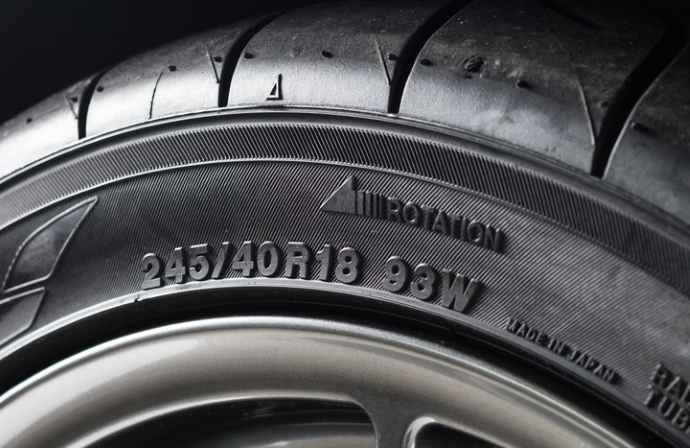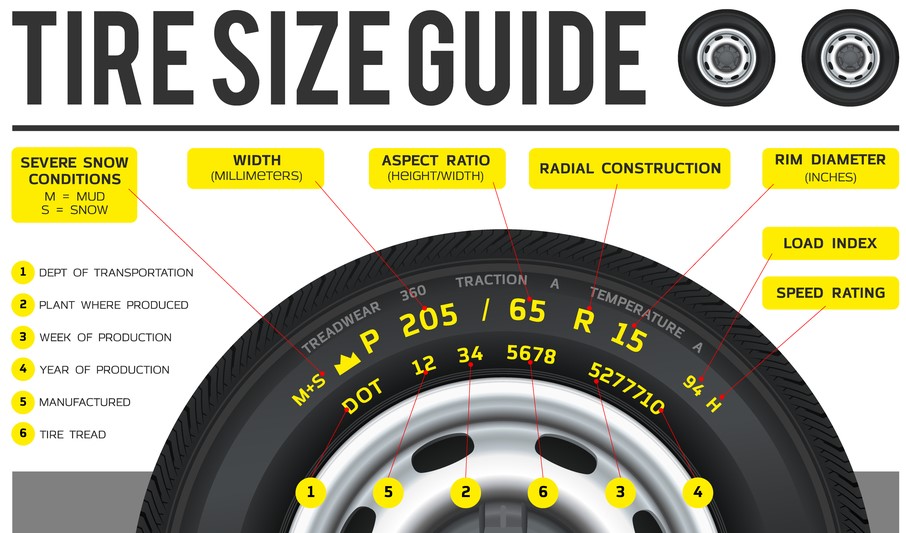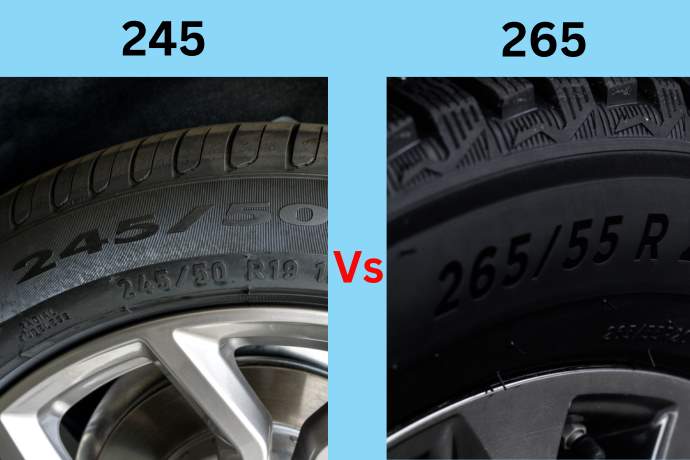When you need to buy new tires for your car, you have many options to choose from.
The 245 and 265 tires are one of them, as they are both popular options for trucks and SUVs.
However, 245 and 265 have noticeable differences that can help you decide which is perfect.
Tires are responsible for a vehicle’s performance, comfort, and safety.
When comparing two tires, it’s important to consider their sizes, speeds, weight-carrying capacities, uses, and gas mileage.
I have briefly described the key differences between 245 and 265 tires in this article, so you can easily pick the right one.
What Does 245 Mean on a Tire

The number 245 on a tire indicates that the tire’s width is 245 millimeters from one sidewall to another.
The tire wall has numbers with special meanings.
For example, a tire size of 245-75R16 means the tire sidewall to sidewall width is 245 millimeters, the aspect ratio is 75, and it fits on a 16-inch wheel.
What Does 265 Mean on a Tire
The number 265 for a tire means the tire width is 265 millimeters.
Generally, it is written on a tire as 265/70R17, which means the tire width is 265 millimeters, the aspect ratio is 60, and it fits on a 17-inch wheel.
245 Vs 265 Tires [08 Major Differences]
There are 8 major differences between 245 and 265 tires, including size, price, performance in adverse weather, weight, fuel consumption, acceleration, handling, and noise.
1. 245 Vs 265 Tires Size

When comparing two tires, the most significant point is their size.
When you compare 245 and 265 tire sizes, it’s easy to see the difference.
A tire’s size includes its overall diameter, width, circumference, and sidewall height.
However, the tire’s revolutions per mile and aspect ratio also relate to tire size.
Overall Diameter
The overall diameter of the 245-75R16 is 774 mm, or 30.47 inches.
In contrast, the overall diameter of 265-75R16 is 804 mm, or 31.65 inches.
In terms of diameter, the 265-75R16 tire is 30 mm, or 1.18 inches, larger than the 245-75R16 tire.
Width
The width of 245-75R16 is 245 mm, or 9.65 inches.
In contrast, the width of 265-75R16 is 264.16 mm or 10.0 inches.
In terms of diameter, the difference between 265-75R16 and 245-75R16 is 19.16 mm, or 0.75 inches.
Circumference
The circumference of 245-75R16 is 2433.32 mm, or 95.8 inches.
In contrast, the circumference of 265-75R16 is 2525 mm, or 99.4 inches.
In terms of circumference, the difference between 265-75R16 and 245-75R16 is 91.68 cm or 3.6 inches.
Sidewall Height
The sidewall height of 245-75R16 is 182.88 mm, or 7.2 inches.
In contrast, the sidewall height of 265-75R16 is 198.63 mm, or 7.82 inches.
Regarding sidewall height, the difference between 265-75R16 and 245-75R16 is 15.75 mm or 0.62 inches.
Revs Per Mile
The 245-75R16 tire’s revolutions per mile are 661 inches, and the revolutions per kilometer are 411 inches.
In contrast, the 265-75R16 tire’s revolutions per mile are 637.22 inches, and its revolutions per kilometer are 395.95 inches.
2. Price
265-75R16 tires are generally more expensive than 245-75R16 tires.
The current price of 245/75R16 is around $153.
In contrast, the current 265/75R16 tire price is around $205.
The price range may change depending on the time frame and selling location.
3. Performance
The performance of the 245 tires in snowy or dry conditions is commendable, but its reputation is not so positive on wet and rainy roads.
In contrast, the 265 tires perform very well on wet and rainy roads as well as in dry or snowy conditions.
The 265 tires are better than the 245 tires in regards to better traction and aggressive driving.
4. Weight
When it comes to performance or fuel economy, tire weight is an important factor.
The weight of the 245 tires is around 44.2 pounds or 20 kilograms.
In contrast, the weight of 265 tires is around 53.5 pounds or 24.27 kilograms.
Regarding weight, the 245 tires are lighter than the 265 tires.
Therefore, the 245 tires have better fuel economy than the 265 tires.
On the other hand, if you want better stability and traction, the 265 tires are better than the 245 tires.
5. Fuel Consumption
The 245 tires are lighter than the 265 tires.
Therefore, the fuel consumption of 245 tires is less than that of 265 tires.
6. Acceleration
Wider tires have the advantage of better acceleration over standard tires.
Wider tires get more contact area with the road, which gives them an advantage over accelerating vehicles.
In this case, the 265 tires perform better than the 245 tires.
7. Handling Ability
Wider tires offer better string grip, which leads to better handling.
The 265 tires are wider than the 245 tires, so the 265 tires have better handling.
8. Comfort and Noise
Comfort and noise are two critical factors that affect the driving experience.
Generally, the 265 tires are more comfortable than the 245 tires.
Compared to the 265 tires, the 245 tires are smoother to drive but less comfortable.
However, the 265 tires are noisier than the 245 tires.
You can also watch this video to learn more about the comparison between 245-65R17 and 265-65R17 tires:
Rim Application of 245 and 265 Tires
The 245 and 265 tires are both suitable for a wide range of uses.
The following are some applications for 245 and 265 tires based on their rim sizes:
| Rim Size | 245 Tires | 265 Tires |
| 14-inch options | 245 60 R14 | — |
| 15-inch options | 245 60 R15
245 50 R15 245 40 R15 |
265 75 R15
265 70 R15 265 50 R15 |
| 16-inch options | 245 75 R16
245 50 R16 245 70 R16 245 45 R16 |
265 70 R16
265 75 R16 |
| 17-inch options | 245 75 R17
245 65 R17 245 70 R17 245 60 R17 245 45 R17 245 40 R17 245 55 R17 245 50 R17 245 30 R17 |
265 70 R17
265 60 R17 265 40 R17 265 60 R17 |
| 18-inch options | 245 55 R18
245 50 R18 245 65 R18 245 60 R18 245 40 R18 245 35 R18 245 45 R18 |
265 70 R18
265 45 R18 265 60 R18 265 40 R18 265 35 R18 265 65 R18 |
| 19-inch options | 245 55 R19
245 50 R19 245 35 R19 245 30 R19 245 45 R19 245 40 R19 |
265 55 R19
265 45 R19 265 35 R19 265 50 R19 265 40 R19 265 30 R19 |
| 20-inch options | 245 60 R20
245 50 R20 245 40 R20 245 30 R20 245 45 R20 245 35 R20 |
265 60 R20
265 50 R20 265 40 R20 265 30 R20 265 45 R20 265 35 R20 |
How to Choose the Right Tires for Your Car
The dimensions and pressure of your tire can be found behind the fuel door or on the driver’s door frame.
You can adjust the tires according to the recommendation on the frame.
There are 3 requirements you need to consider before buying new tires for your vehicle.
1. Rim Width
Ensure the new tires’ width and your vehicle’s tire width are the same.
It is essential for vehicle stability and control systems.
If the tire and rim width isn’t right, it can affect how well the car handles, how fast the tires wear out, and even damage the suspension.
2. Vehicle Size
If you drive a small car, narrow tires like the 245 tires suit you.
On the other hand, if you drive a large SUV or truck, the 265 tires are suitable for your vehicle.
That is how you can choose 245 or 265 tires based on your vehicle size.
3. Road Condition
The last thing you should consider is your road condition, which you always use for daily driving.
You can choose narrow tires like the 245 tires for typical road conditions.
This tire will give a smooth driving experience as well as reduce fuel consumption.
However, the 265 tires are also an option if you don’t have any problem with the extra fuel consumption.
On the other hand, if you are an off-road driver, the 265 is appropriate for your vehicle.
FAQs
Can You Put Wider Tires on the Same Rim?
Yes, you can put wider tires on the same rim within a limit.
The tire width shouldn’t be more than 20 mm wider than the original rim size for safe installation.
It would be best to use a same-width tire compatible with the rim for optimal performance.
You can also use a slightly wider tire if it falls within the recommended range.
Can I Replace 245 Tires with 265?
Yes, you can replace the 245 tires with 265 tires after making corresponding adjustments to the vehicle’s suspension and wheels.
The width difference between 245 and 265 tires is less than 20 millimeters, so it is possible to interchange them.
You may see a slight drop in fuel economy.
Do wider tires handle better?
Yes, most of the time, wider tires have better handling.
Like dry or rainy roads, wider tires provide better grip than narrow tires.
But in extreme winter conditions, narrow tires perform well.
Final Thoughts
Both 245 and 265 tires are popular and reliable.
The 265 tire provides better grip, control, and comfort, while the 245 tire provides better fuel economy and a smooth driving experience.
The 245 tires are lighter and cheaper than the 265 tires.
As a result, the 245 tires are better in some ways, but the 265 tires are better in others.
Now that you know the difference between 245 and 265 tires, you can choose any of them according to your preferences.
Want to explore differences between more tires? Check out the following articles:

